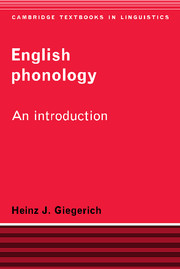Book contents
- Frontmatter
- Contents
- Preface
- 1 Speech sounds and their production
- 2 Towards a sound system for English: consonant phonemes
- 3 Some vowel systems of English
- 4 Phonological features, part 1: the classification of English vowel phonemes
- 5 Phonological features, part 2: the consonant system
- 6 Syllables
- 7 Word stress
- 8 Phonetic representations: the realisations of phonemes
- 9 Phrases, sentences and the phonology of connected speech
- 10 Representations and derivations
- References
- Index
10 - Representations and derivations
Published online by Cambridge University Press: 05 June 2012
- Frontmatter
- Contents
- Preface
- 1 Speech sounds and their production
- 2 Towards a sound system for English: consonant phonemes
- 3 Some vowel systems of English
- 4 Phonological features, part 1: the classification of English vowel phonemes
- 5 Phonological features, part 2: the consonant system
- 6 Syllables
- 7 Word stress
- 8 Phonetic representations: the realisations of phonemes
- 9 Phrases, sentences and the phonology of connected speech
- 10 Representations and derivations
- References
- Index
Summary
This final chapter will be concerned with phonological theory. It has this in common, of course, with the preceding chapters: nothing that has been said about the phonology of English could have been said without reference to a particular theoretical framework. When we talk about the phonemes, allophones, syllables, feet etc. of English we employ theoretical constructs in the analysis of what we perceive to be phonetic facts. The phoneme as such, or any particular phoneme, is not a fact (of English or otherwise) but the result of theoretical reasoning about facts. Similarly, the notions of the syllable and the foot are theoretical constructs, albeit ones that are in some respects associated with certain recurrent phenomena in speech that – through no coincidence, of course – bear the same names.
What will distinguish this chapter from the preceding ones is that here we shall more systematically discuss the phonological theory that we have been employing. We shall begin by asking what it is that we expect a phonological theory to do for us, what the typical ingredients of a phonological theory are, and where the one employed in this book stands within the range of possible phonological theories. In the second part of the chapter we shall review some details of our previous analysis that may be identified as shortcomings of the theory; and we shall look into the possibilities of amending or changing the theory accordingly.
- Type
- Chapter
- Information
- English PhonologyAn Introduction, pp. 291 - 324Publisher: Cambridge University PressPrint publication year: 1992



